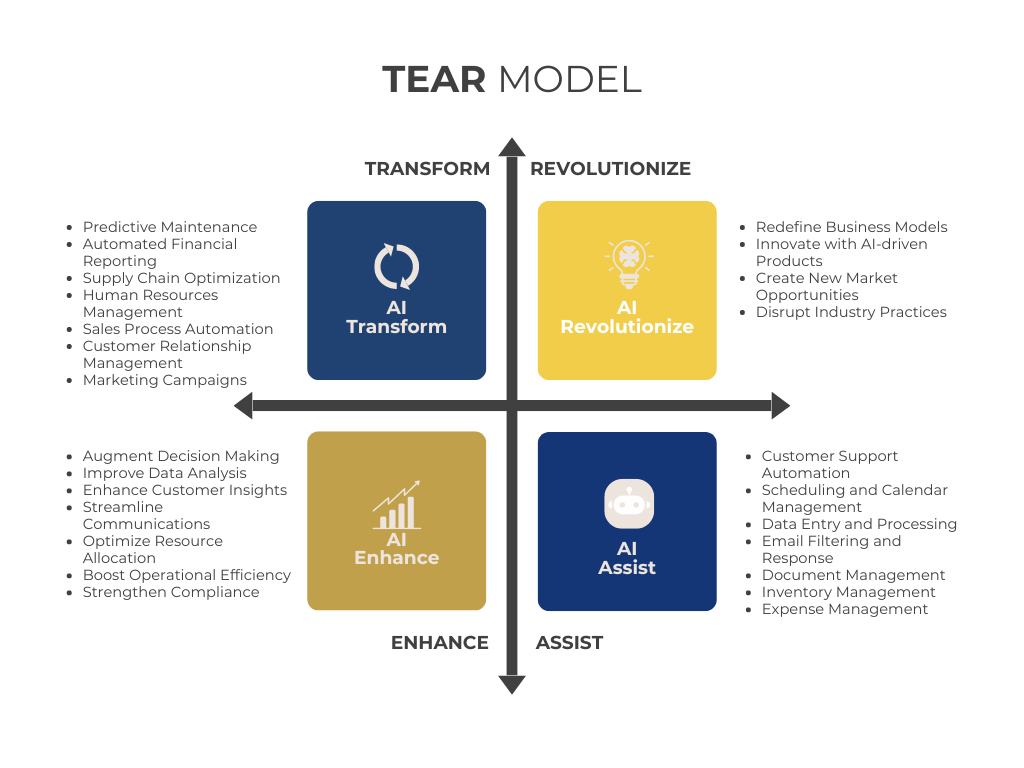Optimizing Workflows with the TEAR Model: A Quick Guide to Using AI for Business Productivity
In my previous article, "AI Transformation: Introducing the TEAR Model for Business," I introduced the TEAR model as a framework for integrating AI into business operations. Today, we will extend this discussion, focusing on the areas that are most impactful for companies just starting to explore and deploy generative AI technology. Specifically this article focused on the Assist and Transform aspects of using generative AI. We'll explore a comprehensive list of workflow improvement ideas and provide a method for helping businesses decide which workflow improvements to prioritize.
The Power of Assist and Transform
AI Assist and AI Transform are pivotal quadrants within the TEAR model, each offering unique benefits and potential for business enhancement. Let's delve deeper into these aspects, emphasizing how generative AI can play a transformative role.
AI Assist – Enhancing Routine Operations
The AI Assist quadrant is about integrating AI to handle routine, repetitive, and time-consuming tasks. Here, AI acts as a diligent aide, improving efficiency and allowing human resources to focus on more strategic initiatives.
Why Focus on Routine Tasks?
For companies exploring the potential of generative AI, it is wise to start with the most routine tasks where human involvement is high. Tasks such as transcribing information from forms, summarizing data, and other repetitive actions are prime candidates for automation. These areas offer significant opportunities for easy workflow automation, allowing businesses to regain substantial amounts of time. This time can then be reinvested in learning more about generative AI and applying it to transform the business into a true 21st-century operation.
Workflow Improvement Ideas for AI Assist:
Customer Support Automation: Implement AI-powered chatbots to handle common customer inquiries, freeing up human agents for more complex issues.
Scheduling and Calendar Management: Use AI to manage appointments and schedules automatically, reducing the administrative burden.
Data Entry and Processing: Automate data entry tasks, ensuring accuracy and saving time.
Email Filtering and Response: Deploy AI to filter and respond to emails, prioritizing urgent messages and handling routine queries.
Document Management: Implement AI for organizing, categorizing, and retrieving documents efficiently.
Inventory Management: Use AI to monitor and manage inventory levels, ensuring optimal stock levels and reducing waste.
Expense Management: Automate expense report processing, ensuring compliance and reducing manual effort.
AI Transform – Redefining Business Processes
In the AI Transform quadrant, AI takes on a more transformative role, automating routine tasks traditionally requiring manual input and significantly enhancing operational efficiency.
Workflow Improvement Ideas for AI Transform:
Predictive Maintenance: Use AI to predict equipment failures and schedule maintenance, reducing downtime.
Automated Financial Reporting: Implement AI to generate financial reports, ensuring accuracy and timeliness.
Supply Chain Optimization: Use AI to optimize supply chain operations, from demand forecasting to logistics management.
Human Resources Management: Automate HR tasks such as recruitment, onboarding, and performance evaluations.
Sales Process Automation: Implement AI to automate sales processes, including lead generation and follow-ups.
Customer Relationship Management: Use AI to analyze customer data and personalize interactions, enhancing customer satisfaction.
Marketing Campaigns: Deploy AI to create, manage, and analyze marketing campaigns, improving targeting and ROI.
Deciding on Workflow Improvements: A Practical Approach
To determine which workflow improvements to prioritize, businesses can follow a structured approach:
Assess Current Workflows: Conduct a thorough assessment of existing workflows to identify bottlenecks and inefficiencies.
Identify High-Impact Areas: Focus on areas where AI can have the most significant impact, whether by reducing costs, improving efficiency, or enhancing customer satisfaction.
Evaluate Feasibility: Consider the feasibility of implementing AI solutions, including the required investment, technological infrastructure, and employee readiness.
Pilot and Iterate: Start with pilot projects to test AI solutions on a small scale, gather feedback, and make necessary adjustments.
Scale Up: Once proven effective, scale up AI implementations across the organization, ensuring continuous monitoring and improvement.
Conclusion: Embracing the Future with Generative AI
The TEAR model provides a strategic framework for integrating AI into business operations. By focusing on the Assist and Transform quadrants, businesses can achieve significant workflow improvements, enhancing efficiency and redefining processes. With a structured approach to identifying and implementing AI solutions, companies can harness the power of generative AI to drive innovation and growth.
Are you ready to embrace the future with generative AI? It's time to tear into the future and see how bright your business can shine!
Get Started - Free TEAR AI Workflow Scorer
To help you get started, we've developed the TEAR AI Workflow Scorer, a tool designed to assess your workflows and determine whether they are more suited for AI Assist or AI Transform. Simply provide your email, describe the task you want to automate, and use the scoring tool to get a clear picture of how AI can benefit your business.


